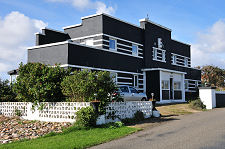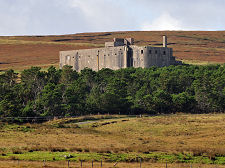 Lyness and Scapa Flow Seen from the HQ and Communications Centre on Wee Fea |
Scotland wears its history really well. Wherever you look, there are amazing relics of a fascinating and often turbulent past. Nowhere is this more true than in Orkney. It's been said that if you scratch Orkney, it bleeds archeology. For most people that phrase brings to mind the huge wealth of prehistoric archeology that can be visited and enjoyed.
But there's also a huge amount here that dates back a century or less, to the conflicts of WWI and, especially, WWII. Scapa Flow was an important naval base during both wars, and during WWII Orkney's pre-war population of a little more than 20,000 people was tripled by the 40,000 or so military personnel based here: with exact numbers varying over time and depending on the number of ships at anchor in Scapa Flow.
There are many places in Orkney that evoke the ghosts of the last century's wars, but for sheer scale alone, there is nowhere else that does it quite like Lyness on the island of Hoy. During the early years of WWII, up to 12,000 personnel were based in and around Lyness to support the defences of the naval anchorage at Scapa Flow and the ships that used it. To put this in context, the population of Kirkwall in 2011 was a little over 9,000.
To support this huge population, hundreds of accommodation huts were built in a number of camps around Lyness. A large wharf was built (known as the Golden Wharf because of its huge cost) along with a series of piers and slipways. Offices, workshops, stores and recreational buildings were erected, including a cinema, a theatre and several churches. Dominating the centre of the settlement were 16 large oil tanks holding fuel for the fleet. Four of these were built in WWI, and the other twelve in the years before WWII. Less obvious were the series of huge underground oil tanks dug into Wee Fea, the hill that rises above Lyness. An earlier headquarters building was replaced in 1943 by an imposing concrete HQ and communications centre, also located high on Wee Fea. (Continues below image...)
 Lyness Naval Cemetery |
Only a tiny proportion of what once stood here still remains, but it is easily enough to give a sense of how this place must have seemed in the early 1940s. Today's visitor will probably approach Lyness on the ferry from Houton in West Mainland. As you approach it is easy to see that one of the oil tanks has been retained, as has the HQ and communications centre high up on the hillside. There is also a scatter of other buildings in various states of repair or disrepair. The most notable of these is a white building which stands just in front of the oil tank. This was originally the oil pumping station, and has since been developed into the Scapa Flow Visitor Centre.
The Scapa Flow Visitor Centre is a "must see" for anyone visiting Hoy. When we last visited in September 2018, the visitor centre was closed for renovation. It reopened in July 2022. We've included on this page a couple of photographs taken inside the visitor centre in 2002: which are now obviously out of date.
Anyone planning to visit Lyness should try to get hold of Wartime Orkney Leaflet N0.1, Lyness Wartime Trail, published by the Landscape Partnership Scheme. When we visited, copies were available in the information room that forms part of the ferry booking area at Lyness; and in the exhibition at the Hoy Hotel. This leaflet is absolutely invaluable for showing you what you are looking at, and filling in the gaps between the surviving parts of the naval base at Lyness.
A little under a mile and about three hundred feet up a track that is signposted to Wee Fea beside the Hoy Hotel is the concrete monolith that is the HQ and communications centre. This is worth viewing in its own right, but by far the best reason to visit is to appreciate the simply incredible view back over Lyness and over Scapa Flow beyond it. This can be seen in the header photograph.
Another must see on any visit to Lyness is the deeply poignant Lyness Royal Naval Cemetery. This was established in 1915, and became the final resting place for 439 burials during WWI, as well as 14 sailors of the German Navy who lost their lives during the scuttling of the German High Seas Fleet in Scapa Flow in 1919. Over 200 more burials date back to WWII, including 26 of the 834 men and boys who were killed when HMS Royal Oak was torpedoed and sunk in Scapa Flow on 14 October 1939. Amongst other burials from WWII are four Germans, one Norwegian, and 20 non-combatants.
While the naval cemetery marks pretty much the northern edge of the naval base at Lyness, anyone travelling south towards Longhope rapidly begins to realise that it sprawled extravagantly in this direction. The entire landscape either side of the road seems to be covered by a thin scatter of old wartime buildings. Easily the most impressive of these is the magnificent Art Deco style house called The Garrison. It takes an act of imagination to realise that this once formed just the entrance and frontage of a vast cinema, The Garrison Theatre, that once extended under an enormous half-barrel corrugated-iron roof far back into the landscape.
Lyness really is a rather special place, and it truly repays the effort involved in reaching and exploring it.
 Lyness Seen from the Ferry |

|
|
|
Visitor InformationView Location on MapWhat3Words Location: ///skate.replays.miracle |
Lyness In Fiction
|
 Lyness Seen from the South |
 The Garrison Theatre: Camp Cinema |
 The Gable End Theatre |
 Recreation Centre and NAAFI |
 Passive Defence Buildings |
 Lyness Naval Cemetery |
 Marine W.W. Taylor, Aged 19 |
 Ferry Office and Information |
 The Ferry: MV Hoy Head |
 Ferry Linkspan |
 Bloody Orkney by Ken Lussey (29 June 2021).
Bloody Orkney by Ken Lussey (29 June 2021).











